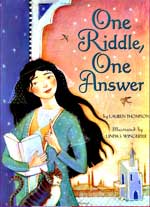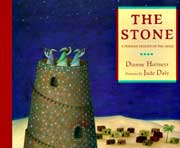The King & Three Thieves: A Persian Tale
byKristen BalouchThe story of the Persian king and the three thieves who help him to learn tolerance and generosity is told in clear simple language that children of all ages can understand. The illustrations are just gorgeous.
Snazzy illustrations energize this Middle Eastern folktale in which a king disguises himself to go among his unsuspecting subjects. King Abbas, a monarch known for his impressive black mustache and accustomed to dining solo, decides to share his abundant food with the needy. Dressed as a pauper, he offers a meal to three unusual men. The first "can whistle a tune that will put anyone to sleep," the second "can see through walls" and the third can sneeze hard enough to "blow a door right off its hinges." When the concealed king says that his mustache is magical too, the three suggest combining forces and robbing the royal palace. This development sorely tests the king's generosity.
Balouch, who retold Celtic,Caribbean and Native American folktales in Listen to the Storyteller, writes according to formula. The events happen "long ago in the faraway land of Persia" and conclude on a positive note: "From that day on the king never ate dinner alone." Yet the compositions break tradition. The lively images, based on Iranian pottery designs, are created with illustration software and look like two-dimensional cut-paper collage. Tumbling shapes and a confetti of dots fill the flattened space, and elephants, camels and onion domes set the desert scene. Balouch engages the eye with sparkling patterns and crisp, solid colors, and she gives her stylized characters the dramatic facial expressions of theatrical masks.
One Riddle, One Answerby Lauren Thompson,
Linda S. Wingerter
Fanciful Persian motifs and patterns set the mood for this original tale. When the sultan rejects all of the plans of his self-serving advisors to find a husband for his daughter, the princess suggests that perhaps she could pose a riddle. A smart and well-educated young woman who loves numbers most of all; Aziza creates a clever conundrum and then travels around the kingdom to find the man who can solve it. Just as she is about to give up hope of finding the perfect husband, a young farmer solves the riddle, explaining his answer to her satisfaction. While most children under third grade will not understand fully the mathematical solution of the riddle, which involves place value, fractions, and multiplication, readers of all ages will appreciate the gorgeous acrylic paintings that feature a broad palette of colors, including every imaginable shade of blue and purple. Playing with perspective and pattern, the artist and author have created a fairy-tale world in which numbers appear in the clouds, on the sides of horses, and even in the sands of the desert. It is a world in which the pursuits of the mind are as important to young princesses as they are to young princes.
The Seven Wise Princesses: A Medieval Persian Epic
byWafa Tarnowska,Nilesh Mistry,Nizami Ganjavi Haft Paykar
Tarnowska bases this multidimensional if uneven collection of tales on 12th-century Persian poet Nizami's epic poem Haft Paykar. One day, Bahram, the son of the shah ofPersia, discovers a secret room in the grand palace built for him by the king of Yemen, to whom the shah has sent his son to be raised. The portraits of seven fetching princesses- from India, China, Russia, Greece, Arabia, Persia and Morocco- line the chamber's walls, and Bahram vows he will one day meet these beauties. After his father's death and his ascension to shah, Bahram invites them to visit his own palace, and they each tell him a story, the morals of which convey the importance of patience, truth, faith, passion, serenity, fairness and devotion to God. Many of the plots are riveting, such as "The Raja Who Dressed in Black," who grows too impatient to achieve a kiss from the queen of Houris (fairies), or "The Story of Good and Bad," in which a good friend forgives the acts of a bad one; but others seem protracted and labyrinthine (e.g., the Moroccan princess's tale). The language does not achieve that of its poetic origins; the prose is often clunky or clichéd (a wealthy Egyptian is described as having been "born with a silver spoon in his mouth"). And readers may be caught off-guard by the abrupt ending of the frame story (Bahram disappears in a cave). Mysteries Stories from the Silk Road ornately bordered, gouache paintings effectively portray the thematic and chromatic content of each entry and include some lovely, intricate mosaics and patterns. Tarnowska's retelling offers insight into a range of cultural lore and symbolism, but may prove esoteric for many young readers.
The Stone: A Persia Legend of the Magi
by Dianne Hofmeyr, Jude Daly
According to the source notes, this story of the three Magi is based on versions of the tale heard by Marco Polo on his travels. The wise men are amazed by the beautiful star that appears in the night sky. Jasper thinks it's a planet; Melchior, a comet; Balthasar says, "It's a mystery. We must consult our charts and scrolls." They discover the legend of a "baby whose birth would be announced by a star" and decide to find him and honor him with gifts. They give him gold (for a king), myrrh (for a healer), and holy incense (for a holy man). He accepts the gifts and offers one in return. When they discover that it is only a stone, Jasper throws it into a well in disgust. Up bursts a tower of flame? Indicating to the Magi that the child is all things: a true king, a healer, and a holy one. The fire will "bring justice and healing and peace into the world." This variant of the Biblical tale of Jesus's birth includes unusual details such as Magi who are more comical than wise, never agreeing about anything, and a baby (unnamed here) who is old enough to return a gift of his own. The message, however, is strong and just right for the season. Daly's luminous watercolors capture the sweep of the desert, the beauty of the night sky, and the gracefully stylized characters; an interesting enhancement to Christmas collections.
The Legend of the Persian Carpet
by Tomie dePaola, Claire EwartDePaola (Strega Nona) retells--but does not illustrate--a legend about the origin of the jewel-patterned Persian rug. King Balash's brilliant giant diamond is stolen by a stranger who accidentally drops it onto a rocky plain, where the jewel shatters into thousands of glittering fragments. When apprentice carpet-weaver Payem leads the ruler to the "carpet" formed by the dazzling fragments, the overwhelmed king refuses to leave the beautiful sight behind. To lure their leader back to his palace, Payem and his fellow apprentices weave a silk carpet as brilliantly colored as the one made of diamond. A parable of the healing powers of art, this foray into the rich culture of theMiddle East is ably recounted. Ewart's illustrations, with their unremarkable compositions and stiff, look-alike figures, are less pleasing.